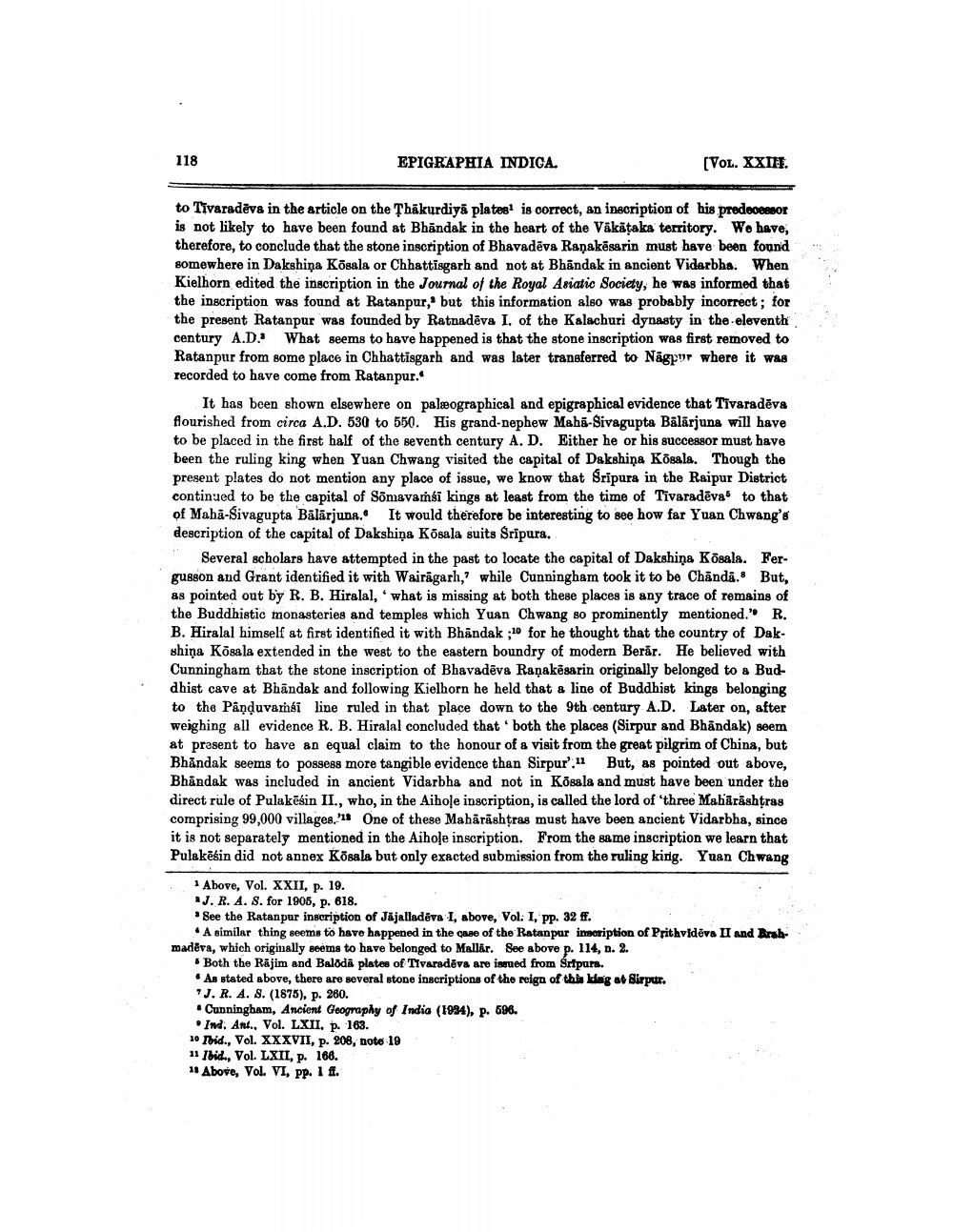________________
118
EPIGRAPHIA INDICA.
(VOL. XXIII.
to Tivaradēva in the article on the Thakurdiyā plates is correct, an inscription of his predecesor is not likely to have been found at Bhāndak in the heart of the Väkäţaka territory. We have, therefore, to conclude that the stone inscription of Bhavadēva Ranakēsarin must have been found somewhere in Dakshina Kosala or Chhattisgarh and not at Bhandak in ancient Vidarbha. When Kielhorn edited the inscription in the Journal of the Royal Asiatic Society, he was informed that the inscription was found at Ratanpur, but this information also was probably incorrect; for the present Ratanpur was founded by Ratnadēva I. of the Kalachuri dynasty in the eleventh century A.D.: What seems to have happened is that the stone inscription was first removed to Ratanpur from some place in Chhattisgarh and was later transferred to Nagpur where it was recorded to have come from Ratanpur.
It has been shown elsewhere on palæographical and epigraphical evidence that Tivaradēva flourished from circa A.D. 530 to 550. His grand-nephew Maha-Sivagupta Bālārjuna will have to be placed in the first half of the seventh century A. D. Either he or his successor must have been the ruling king when Yuan Chwang visited the capital of Dakshina Kosala. Though the present plates do not mention any place of issue, we know that Sripura in the Raipur District continued to be the capital of Sõmavamsi kings at least from the time of Tīvaradēva to that of Maha-Sivagupta Bälärjuna.. It would therefore be interesting to see how far Yuan Chwang's description of the capital of Dakshiņa Kosala suits Sripura.
Several scholars have attempted in the past to locate the capital of Dakshina Kosala. Fergusson and Grant identified it with Wairāgarh," while Cunningham took it to be Chanda.& But, as pointed out by R. B. Hiralal, 'what is missing at both these places is any trace of remains of the Buddhistic monasteries and temples which Yuan Chwang so prominently mentioned. R. B. Hiralal himself at first identified it with Bhāndak ;10 for he thought that the country of Dakshiņa Kosala extended in the west to the eastern boundry of modern Berăr. He believed with Cunningham that the stone inscription of Bhavadēva Raņakēsarin originally belonged to a Buddhist cave at Bhāndak and following Kielhorn he held that a line of Buddhist kings belonging to the Panduvamai line ruled in that place down to the 9th century A.D. Later on, after weighing all evidence R. B. Hiralal concluded that both the places (Sirpur and Bhāndak) seem at present to have an equal claim to the honour of a visit from the great pilgrim of China, but Bhandak seems to possess more tangible evidence than Sirpur':11 But, as pointed out above, Bhandak was included in ancient Vidarbha and not in Kösala and must have been under the direct rule of Pulakēsin II., who, in the Aihose inscription, is called the lord of three Mahārāshtras comprising 99,000 villages.'18 One of these Mahārāshtras must have been ancient Vidarbha, since it is not separately mentioned in the Aihole inscription. From the same inscription we learn that Pulakēśin did not annex Kõsala but only exacted submission from the ruling king. Yuan Chwang
Above, Vol. XXII, p. 19. *J. R. A. S. for 1905, p. 618. * See the Ratanpur inscription of Jājalladēva I, above, Vol. I, pp. 32 ff.
• A similar thing seems to have happened in the case of the Ratanpur inscription of Prithvideva II and Prahmadēva, which originally seems to have belonged to Mallår. See above p. 114, n. 2.
. Both the Räjim and Balodā plates of Tivaradēvs are issued from Sripurs. • As stated above, there are several stone inscriptions of the reign of the bag & Sirpur.
J. R. A. 8. (1875), p. 260. • Cunningham, Ancient Geography of India (1994), p. 686. . Ind. Ant., Vol. LXII. p. 163. 10 Toid., Vol. XXXVII, p. 208, note 19 11 Ibid., Vol. LXII, p. 168. 11 Above, Vol. VI, pp. 1 ff.




